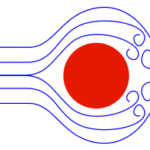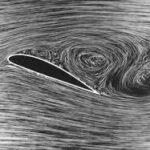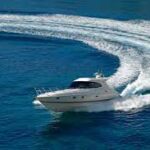In this article we will discuss about different Pressure Drag Examples. The pressure drag depends on the cross sectional area of the body rather than the surface area exposed.
Pressure Drag Examples are frequently seen in our daily life. Pressure drag occurs due to the increased pressure on the front end and decreased pressure on the rear end of an object while travelling through a fluid.
Different examples of pressure drag are listed below:
- A spherical shaped body moving through air
- A bicycle
- Swimmers
- A cylindrical body
- A moving car
- An airfoil or aerofoil with large angle of attack
- A moving truck
- A skydiver falling through the sky
- A boat travelling in water
- A piece of brick
Pressure drag is also caused by stationary object around which fluid medium passes. Streamlining reduces the Pressure Drag.
A spherical shaped body moving through air
A spherical shaped body experience high pressure drag while moving through a fluid due to its shape. The more surface area the more air particles will hit and greater the resistance experienced by the body.
Due to the boundary layer separation in case of a spherical body low pressure wake is formed behind the body.

A bicycle
Aerodynamic drag is indeed a major resistive force in cycling, every bicyclist has to overcome the wind resistance. Pressure drag plays a major role in cycling, mainly caused by the air particles push together on the front facing surfaces and more spaced out on the back surfaces creating a vast pressure difference between front and back ends.
Every cyclist who has ever pedalled into a stiff headwind knows about wind resistance. It’s exhausting! In order to move forward, the cyclist must push through the mass of air in front of him.

Swimmers
Different forms of drag forces like friction, pressure and wave drag continuously act on a swimmer as he steps down in the pool to their final touch at the wall. Frictional drag occurs as a result of rubbing of water molecules with the body of the swimmer, a smoother body of the swimmer reduces friction to some extent.
While swimming at higher speed, there is an increase in pressure in the frontal region (head of the swimmer) creating a pressure difference between the two ends of the swimmer’s body. This difference in pressure generates turbulence behind the swimmer’s body, this extra resistance force is the pressure drag.
Wave drag occurs as a result of the swimmer’s body submerged in the water and partly out of the water. All the wave drag force is generated from the head and shoulder portion of swimmer’s body.

A cylindrical body
A cylindrical body is an example of bluff body that means high pressure drag is created due to its shape. A bluff body is a body whose surface is not aligned with the streamlines whenever it is placed in a flow of air or liquid.
A cylinder offers less resistance in terms of frictional drag but a offers a large pressure drag due to the eddy formation after the body moves through a large wake region.
A moving car
In case of a moving car, the magnitude of drag force is equal and acting in an opposite direction to the force that the engine creates at the wheels of the vehicle. Due to these two equal and opposite forces acting on the car, the net resulting force becomes zero and the car can maintain a constant speed.
If the we make the force produced by the engine zero by keeping the car in a neutral position for a while then only drag force acts on the car. At this condition, the net force is available on the car and the car decelerates.
Pressure drag comes from the eddying motions that are set up in the fluid by the passage of a body. The drag is associated with the formation of a wake in the flow.
A truck with flat frontal area experiences high air resistance than a sports car with streamlined body.

An aerofoil with large angle of attack
A flow which experiences an increased pressure is known as flow in adverse pressure gradient. After following this condition far enough boundary layer separates from the surface and creates eddies and vortices behind the body. As a result pressure drag increases(due to vast pressure differential between two ends) and lift decreases.
In case of an aerofoil with higher angle of attack, the adverse pressure gradient on the top rear portion produces a separated flow. Due to this separation, wake size increases and pressure loss occurs due to eddy formation. As a result pressure drag increases.
At a higher angle of attack, a large fraction of the flow above the top of the aerofoil may be separated, at this point pressure drag is higher than the viscous drag.

A moving truck
In case of a commercial truck the pressure drag or form drag is quite high due to the larger frontal cross sectional area. Pressure drag produced is greatly influenced by the shape and size of the object.
Bodies with a larger presented cross section experiences higher drag than thinner or streamlined objects.
Pressure drag follows the drag equation that it increases with the square of the speed and thus plays a great role for high speed vehicles.
The performance and fuel efficiency of a vehicle depends on two aerodynamic forces pressure drag and skin friction drag. An effort is always given to shape a body with less drag.

A skydiver falling through the sky
When a skydiver jumps from the airplane both air resistance or drag and gravitational force act on his body. Gravitational force remains constant but the air resistance increases with increase in earthbound velocity.
The force of the air particles striking the body can be changed by altering his body position (the cross sectional area of the body). This changes the velocity of the skydiver towards the earth.
The drag(resistance) force experienced by the body can be represented by the following formula:

Where D is the drag coefficient,
p is the density of the medium, in this case air,
A is the cross-sectional area of the object, and
v is velocity of the object.

A boat travelling in water
When a boat passes through a fluid medium eddying motion set behind the body which results in pressure drag. This drag is associated with wake formation which can be observed behind a passing boat.
In comparison to friction drag, pressure drag is less sensitive to Reynolds number. Pressure drag is important for separated flows.
This drag force can be observed in the form of a wake seen behind a passing boat.

A piece of brick
A piece of brick due to its bluff body like structure experiences high pressure drag when moves through a fluid.
For a bluff body dominant source of drag is pressure drag and always depend on the cross sectional area.

I am Sangeeta Das. I have completed my Masters in Mechanical Engineering with specialization in I.C Engine and Automobiles. I have around ten years of experience encompassing industry and academia. My area of interest includes I.C. Engines, Aerodynamics and Fluid Mechanics. You can reach me at